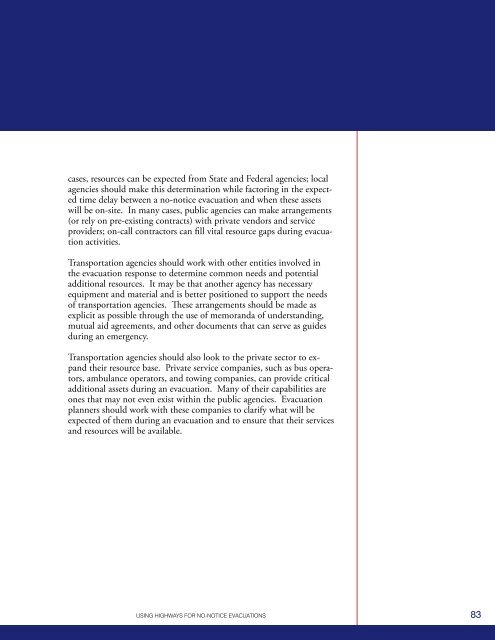During the planning process, each agency should clarify its roles andresponsibilities in an evacuation and then determine what assets it willrequire to per<strong>for</strong>m those duties. These requirements will vary greatlydepending on the type of agency, its mission during an emergency,and the anticipated scope of its activities. In the case of transportationagencies, they are likely to need some combination of the followingresources:n Staff personnel (variety of roles and expertise) available and on-siten Facilities (administration offices, TMCs, TOCs)n In<strong>for</strong>mation systems (ITS, computer networks, software, ancillaryhardware such as cameras and road sensor loops)n Communications systems (landline telephone, mobile phones, radiosystem, e-mail)n Vehicles (staff transport, transit vehicles, heavy equipment)n Miscellaneous material (Jersey barriers, traffic cones)Any resource management that can be done in advance of an evacuationwill enable agencies to respond more effectively and efficientlywhen an incident occurs. Each agency should create and maintain aninventory of its assets, so it can better understand its level of preparednessand potential gaps related to its activities during an evacuation.This inventory needs to include in<strong>for</strong>mation about type of asset, quantity,condition, operational deployment status, location, and resourceorderingin<strong>for</strong>mation, such as an emergency call number <strong>for</strong> immediateaccess. By analyzing the inventory, transportation agencies can makebetter decisions about which traffic management tactics to employ,recognizing that some tactics may be unrealistic in a <strong>no</strong>-<strong>no</strong>tice contextbecause the necessary resources would <strong>no</strong>t be immediately available. I<strong>no</strong>ther cases, the agency may have the resources, but their location anddisruption to the transportation network would make rapid acquisitiondifficult. In these cases, the agency may consider relocating orpre-positioning its mobile assets in locations that will better supportemergency activity.Where critical resource gaps are identified, agencies should determinethe best way to obtain the missing items. This may involve the procurementof additional assets or coordination with other entities todetermine where surplus inventories exist and can be shared. In some82 USING HIGHWAYS FOR NO-NOTICE EVACUATIONS
cases, resources can be expected from State and Federal agencies; localagencies should make this determination while factoring in the expectedtime delay between a <strong>no</strong>-<strong>no</strong>tice evacuation and when these assetswill be on-site. In many cases, public agencies can make arrangements(or rely on pre-existing contracts) with private vendors and serviceproviders; on-call contractors can fill vital resource gaps during evacuationactivities.Transportation agencies should work with other entities involved inthe evacuation response to determine common needs and potentialadditional resources. It may be that a<strong>no</strong>ther agency has necessaryequipment and material and is better positioned to support the needsof transportation agencies. These arrangements should be made asexplicit as possible through the use of memoranda of understanding,mutual aid agreements, and other documents that can serve as guidesduring an emergency.Transportation agencies should also look to the private sector to expandtheir resource base. Private service companies, such as bus operators,ambulance operators, and towing companies, can provide criticaladditional assets during an evacuation. Many of their capabilities areones that may <strong>no</strong>t even exist within the public agencies. Evacuationplanners should work with these companies to clarify what will beexpected of them during an evacuation and to ensure that their servicesand resources will be available.USING HIGHWAYS FOR NO-NOTICE EVACUATIONS83
















